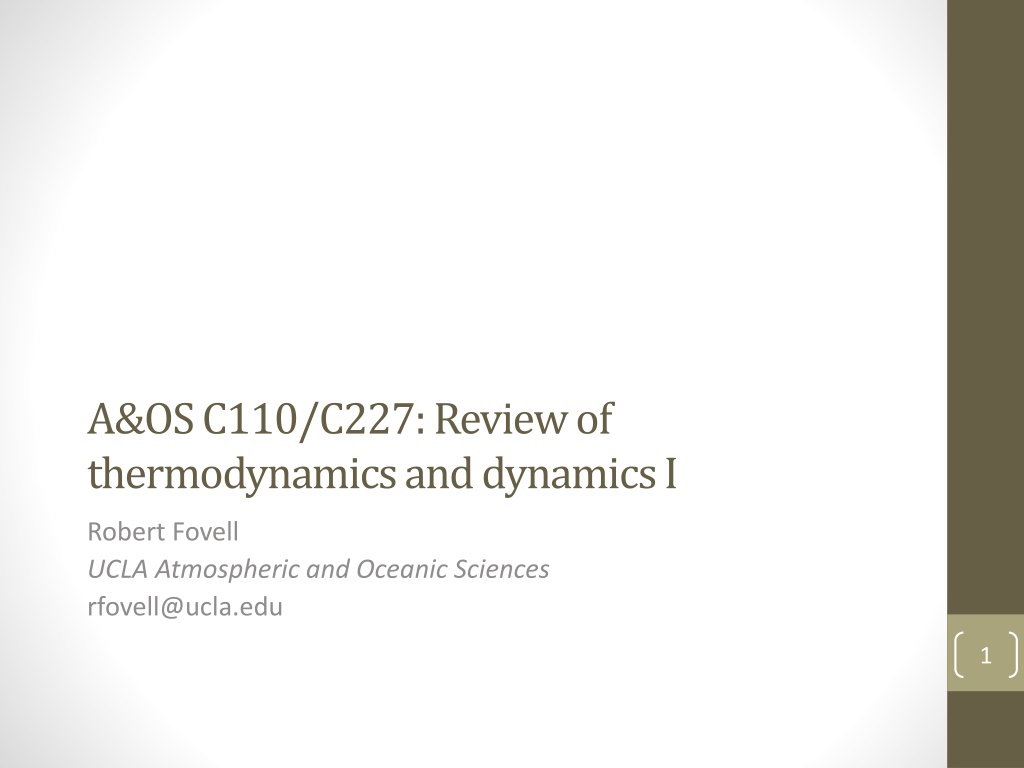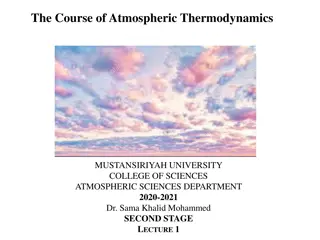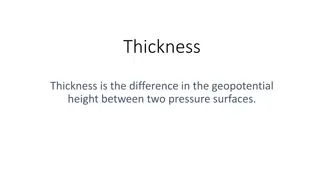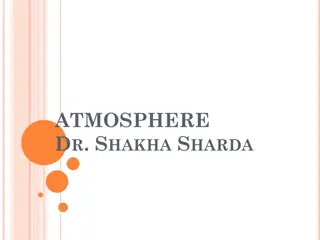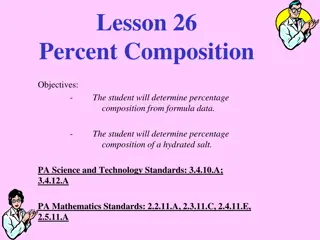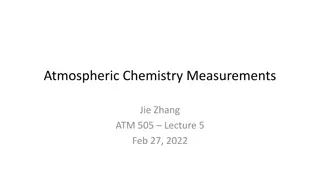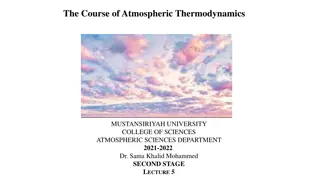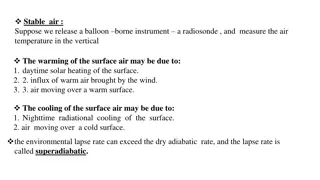Understanding Atmospheric Composition and Structure
The presentation covers fundamental concepts related to the Earth's atmosphere, including its composition, origin of oxygen, dry and moist layers, standard atmosphere layers, and temperature variations. Key topics discussed include the primordial atmosphere, atmospheric constituents, water vapor distribution, and tropospheric and stratospheric characteristics. The content provides insights into thermodynamic calculations and atmospheric dynamics, offering a comprehensive overview for better understanding atmospheric science.
Download Presentation

Please find below an Image/Link to download the presentation.
The content on the website is provided AS IS for your information and personal use only. It may not be sold, licensed, or shared on other websites without obtaining consent from the author. Download presentation by click this link. If you encounter any issues during the download, it is possible that the publisher has removed the file from their server.
E N D
Presentation Transcript
A&OS C110/C227: Review of thermodynamics and dynamics I Robert Fovell UCLA Atmospheric and Oceanic Sciences rfovell@ucla.edu 1
Notes Everything in this presentation should be familiar Please feel free to ask questions, and remember to refer to slide numbers if/when possible If you have Facebook, please look for the group UCLA_Synoptic . You need my permission to join. (There are two Robert Fovell pages on FB. One is NOT me, even though my picture is being used.) 2
The atmosphere Primordial atmosphere Volcanic activity, rock outgassing H2O vapor, CO2, N2, S no oxygen Origin of oxygen: dissociation of water vapor by absorption of UV (minor), and photosynthesis (major) Present composition of dry air 78% N2 21% O2 1% Ar Minor constituents of dry air include CO2 0.039%, CH4 0.00018%, O3 < 0.00005% 4
Atmosphere: Dry and moist Dry air constituents are well-mixed and vary only slowly over time and space Roughly constant over lowest 80 km (50 mi) Very convenient for thermodynamic calculations Water vapor ( wv ) 0-4% of total atmospheric mass, but also concentrated near surface for these reasons Surface source Efficient return mechanism (precipitation) Absolute humidity is a very strong function of temperature (T) Revealed by Clausius-Clapeyron equation 6
Standard atmosphere Averaged over time and horizontal space Four layers: Troposphere Stratosphere Mesosphere Thermosphere Lapse rate = how T decreases with height 7 Temperature vs. height for standard atmosphere
Standard atmosphere Troposphere turning sphere Averages 12 km (7.5 mi) deep Top = tropopause T range 15 C @ sfc to - 60 C at tropopause Average tropospheric lapse rate: 6.5 C/km (19 F/mi) 8 Temperature vs. height for standard atmosphere
Standard atmosphere Stratosphere layered very stable Extends upward to 50 km Top = stratopause T increases with height (lapse rate negative) UV interception by O2 and O3 lid for troposphere in a sense 9 Temperature vs. height for standard atmosphere
Standard atmosphere Mesosphere middle sphere T decreases with height again Top = mesopause Thermosphere Very hot and yet no heat (very little mass) Freeze and fry simultaneously 10 Temperature vs. height for standard atmosphere
Standard atmosphere Tropospheric T variation 15 C at surface -60 C at 12 km elevation If warm air rises and cold air sinks , why doesn t the troposphere turn over? 11 Temperature vs. height for standard atmosphere
Pressure Pressure = force per unit area p = N/m2 = Pascal (Pa) Air pressure largely due to weight of overlying air Largest at the surface, zero at atmosphere top Decreases monotonically with height (z) Pressure linearly proportional to mass 12
Pressure g ~ 9.81 m/s2 at sea-level 13
Sea-level pressure (SLP) For surface p = 1000 mb: 50% of mass below 500 mb 80% of mass below 200 mb 99.9% of mass below 1 mb mb = millibar hPa = hectopascal 1 mb = 100 Pa 14
Various p and z levels 15 Infer how pressure varies with height
Pressure vs. height 16 P0 = reference (surface) pressure H = scale height
Density = = mass/volume 17 Infer how density varies with height
p and vs. height and and ln 18
Warm air rises and cold air sinks NOT always true. True statement is: less dense air rises, more dense air sinks Note near-surface air, although warm, is also more dense 19 Temperature vs. height for standard atmosphere
Warm air rises and cold air sinks 20 Temperature vs. height for standard atmosphere
System and environment System = what we wish to study View as control mass or control volume Control mass (CM) Define some mass, hold fixed, follow it around Control volume (CV) Define and monitor a physical space Environment = everything else that may interact with the system 22
System states Systems may be open or closed to mass Open systems permit mass exchange across system boundaries Our CVs are usually open Strictly speaking, a CM is closed Closed systems may be isolated or nonisolated Isolated systems do not permit energy transfer with environment Closed, isolated system = environment doesn t matter 23
Lagrangian vs. Eulerian CM is the Lagrangian viewpoint Powerful, desirable but often impractical Total derivatives Freeway example CV is the Eulerian viewpoint Observe flow through volume Partial derivatives 24
Air parcel Our most frequently used system CM (usually!) Lagrangian concept Monitor how T, p, and V change as we follow it around 25
Conventions We often use CAPITAL letters for extensive quantities, and lower case for specific quantities Specific = per unit mass Example: U is internal energy, in Joules u is specific internal energy, in J/kg Unfortunately, u is also zonal wind velocity Aside: Temperature T is essentially specific, but capitalized (and isn t per unit mass anyway) Pressure p is fundamentally extensive, but lower case (and isn t per unit mass anyway) 26
Energy and the 1st law Total energy = KE + PE + IE Conserved in absence of sources and sinks Our main use of 1st law: monitor changes in internal energy (IE or u) owing to sources and sinks How do we change system u? With energy transfer via heat Q or q work W or w Caveat: w is also vertical velocity, and q may also refer to water vapor specific humidity 27
Work Work = force applied over a distance Force: N, distance: m Work: Nm = J = energy Our principal interest: CM volume compression or expansion (dV) in presence of external pressure (p) W > 0 if dV > 0 28
Work W > 0 when system expands against environment 29
Heat Diabatic heat Diabatic: Greek for passable, to be passed through Internal energy exchanged between system and environment q > 0 when energy flow is INTO system Adiabatic= system is isolated Adiabatic: Greek for impassable, not to be passed through 30
Caution on nomenclature We should use diabatic when the energy exchange is between system and environment But, what if the heat source or sink is inside the system? That s adiabatic, but q 0 Our interior heat source will be water changing phase Dry adiabatic: q = 0 No heat source, outside OR inside dry really means no water phase changes Moist adiabatic: q 0, but heat source/sink is inside system moist implies water phase change Synonyms include saturated adiabatic and wet adiabatic Can also be referred to as diabatic ! 31
1st law In the absence of KE and PE Other ways of writing this 33 Most of my examples will be per unit mass.
State properties Internal energy u is a state property Changes in state properties are not path-dependent Other state properties include m, T, p, , V, etc. 34
Path-dependence Work and heat are path-dependent 36
Path-dependence A cyclic process starts and ends with the same state property values but the cyclic process can have net heat exchange and do net work 37
Path-dependence Black path 38
Path-dependence Red path 39
Carnot cycle 4-step piston cycle on a CM 2 steps of volume expansion, 2 of volume compression 2 steps are isothermal, 2 are (dry) adiabatic Warm and cold thermal reservoirs external to system Start and end with temperature T1 and volume V1 40
Carnot Step 1 Isothermal volume expansion Add heat QA from warm reservoir T2 = T1 V2 > V1 41
Carnot Step 2 Adiabatic volume expansion No heat exchange T3 < T2 V3 > V2 42
Carnot Step 3 Isothermal volume compression Lose heat QB to cold thermal reservoir T4 = T3 V4 < V3 43
Carnot Step 4 Adiabatic volume compression No heat exchange T1 > T4 V1 < V4 44 Returned to original state T1, V1. Cycle is complete.
